
Talbot County is located in the heart of the Eastern Shore of Maryland in the U.S. state of Maryland. As of the 2010 census, the population was 37,782. Its county seat is Easton. The county was named for Lady Grace Talbot, the wife of Sir Robert Talbot, an Anglo-Irish statesman, and the sister of Lord Baltimore.

Easton is an incorporated town in and the county seat of Talbot County, Maryland, United States. The population was 15,945 at the 2010 census, with an estimated population in 2019 of 16,671. The primary ZIP Code is 21601, and the secondary is 21606. The primary phone exchange is 822, the auxiliary exchanges are 820, 763, and 770, and the area code is 410.
Wye Mills is an unincorporated community in Talbot County, Maryland, United States, located at an altitude of 20 feet (6.1 m). Wye Mills is located at the intersection of Maryland routes 404 and 662, just south of the Queen Anne's County border.

There are more than 1,500 properties and districts listed on the National Register of Historic Places in the U.S. State of Maryland. Each of the state's 23 counties and its one county-equivalent has at least 20 listings on the National Register.

Wye House is a historic residence and former headquarters of a historic plantation house northwest of Easton in rural Talbot County, Maryland. Built in 1781–1784, it is a high-quality and well-proportioned example of a wooden-frame Southern plantation house. It was designated a National Historic Landmark in 1970.

The Chase–Lloyd House is a historic house at 22 Maryland Avenue in Annapolis, Maryland. Built in 1769–1774, it is one of the first brick three-story Georgian mansions to be built in the Thirteen Colonies, and is one of the finest examples of the style. Its interiors were designed by William Buckland. Its construction was started for Samuel Chase, who would later be a signatory to the Declaration of Independence and Associate Justice of the Supreme Court, but Chase sold the building unfinished to Edward Lloyd IV in 1771. Lloyd completed the house in 1774 with assistance from Buckland and another architect, William Noke. The house remained in the Lloyd family until 1847, when it was sold to a relation of Chase. Hester Anne Chase was the daughter of Jeremiah Townley Chase who was Samuel Chase's cousin. When she died, she left the house to her 3 orphan nieces, Francis, Matilda, and Hester. In 1888 the house was bequeathed for use as a home for elderly women by the will of the last living niece, Hester. It continues in this use today. While the upper floors are off limits to visitors, the main floor and the extensive gardens are open to the public.

The McKinstry's Mills Historic District is a national historic district in Union Bridge, located in Carroll and Frederick County, Maryland. The district comprises the entirety of the settlement of McKinstry's Mills, a 26-acre (110,000 m2) hamlet consisting of six separate properties that were owned and developed in the 19th century by the McKinstry family, local millers. At the center is a 3+1⁄2-story grist mill constructed in 1844. Also included are the McKinstry homestead, built between 1825 and 1835; the residence of miller Samuel McKinstry, dated 1849; a store building of 1850; and two other small houses and a variety of outbuildings. There is also a 1908 Warren pony truss bridge.
Marsh Mills, also known as Haley's Mill or Spielman Mill, is a historic home located at Fairplay, Washington County, Maryland, United States. It is a 2+1⁄2-story, three-bay-wide limestone house. The structure was built about 1850 as a mill, then converted to a creamery in the 1880s. Traces of the millrace are still visible where it exits the south end of the building and passes beneath the road. Also on the property is an American Foursquare–style frame house which may incorporate remnants of the original log house which served as the original miller's dwelling.
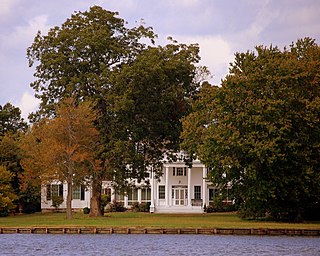
The Anchorage is a historic home in Easton, Talbot County, Maryland, USA. It is a five-part house with a large 2+1⁄2-story center section and small hyphens and wings. It has a 2-story Greek Revival porch supported by four Doric columns. The main section was built around 1810, with the wings probably added during the 1830s. Also on the property is a log smokehouse and a windmill. The Lloyd family of Wye House bought the property in 1831 and one of Governor Edward Lloyd's daughters and her husband went to live in it.
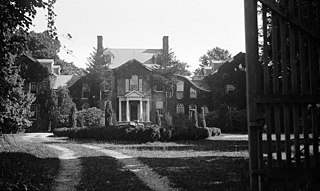
Hope House is a historic home located near Easton, Talbot County, Maryland. It was listed on the National Register of Historic Places in 1979.
The Wye Town Farm House is a historic home in Easton, Talbot County, Maryland, United States. It is of brick construction, one and one-half stories high and two rooms deep with a small one-story brick kitchen. A two-story addition was made in the 20th century. The original section of the house dates from about 1800.
Sherwood Manor, also known as Sherwood's Neck, is a historic home about four miles west of Saint Michaels, Talbot County, Maryland. It is a post-Revolutionary War brick structure located on a small point of land in Hemmersley Creek. The house is a five bay, two story brick structure, with an unusual pair of inset panels, the size of windows, on both stories of the west gable end. It was acquired in 1771 by Matthew Tilghman, a Maryland statesman and onetime member of the Continental Congress, to augment his own large property holdings in the area, which included his home at Rich Neck Manor. Matthew Tilghman's son, Lloyd Tilghman, occupied the Sherwood property and built Sherwood Manor some time before 1798.
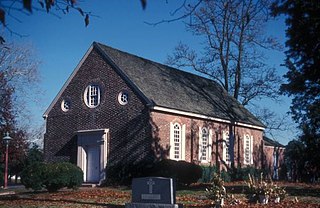
Old Wye Church is a historic Episcopal church at Wye Mills, Talbot County, Maryland. It is a one-story, gable-roofed, rectangular brick structure originally constructed in 1717–21. It was extensively renovated in 1854 and restored to its 18th-century appearance in 1947–49. It embodies the distinctive characteristics of Georgian Anglican architecture in its brick construction, semicircular-arched window openings, shouldered buttresses, rectangular plan, and simple massing.
The Persistence is a Chesapeake Bay log canoe, built in the 1890s, possibly by John B. Harrison in Tilghman, Maryland. She measures 32'-41⁄2" long, with a beam of 6'-111⁄2" and is double-ended with no longhead on her bow. She is one of the last 22 surviving traditional Chesapeake Bay racing log canoes that carry on a tradition of racing on the Eastern Shore of Maryland that has existed since the 1840s. She is located at St. Michaels, Talbot County, Maryland.
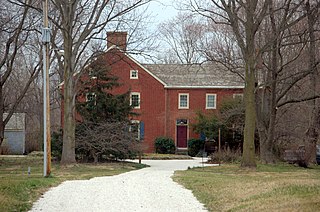
Wilton is a historic home located at Wye Mills, Queen Anne's County, Maryland. It consists of the original brick structure, built between 1749 and 1770, which is a three-bay, 2+1⁄2-story block, approximately 22 feet by 26 feet. About 1800 a major Flemish bond brick addition was made to the house.
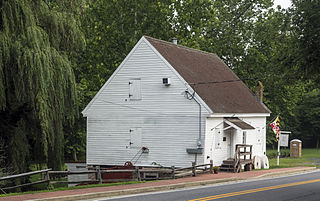
The Wye Mill is the oldest continuously operated grist mill in the United States, located at Wye Mills, Queen Anne's County and Talbot County, Maryland, United States. It is the earliest industrial site on the Eastern Shore in continuous use; dating to the late 17th century. It is a wood-frame, water-powered grist mill, with a 19th-century 26 HP 10-foot-diameter (3.0 m) Fitz steel overshot wheel. The mill retains nearly all of its late-18th-century equipment. The Wye Mill was one of the first grist mills to be automated with the Oliver Evans process, which is still in use today.
The Nellie L. Byrd is a Chesapeake Bay skipjack, built in 1911 at Oriole, Maryland. She is a 53.6' long two-sail bateau, or "V"-bottomed deadrise type of centerboard sloop. She has a beam of 26.7', a depth of 4.8', and a net tonnage of 18 tons. She is one of the 35 surviving traditional Chesapeake Bay skipjacks and a member of the last commercial sailing fleet in the United States. When listed, she was located at Tilghman, Talbot County, Maryland. Since 2005, she is located at Middle River, Maryland, Baltimore County, Maryland.
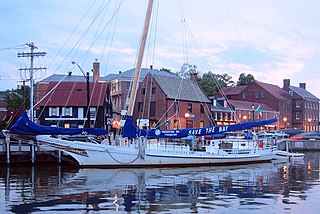
The Stanley Norman is a Chesapeake Bay skipjack, built in 1902 by Otis Lloyd, Salisbury, Maryland. She is a 48-foot-3-inch-long (14.71 m) in Length overall with length on deck (LOD) OF 47.5-foot-long (14.5 m) two-sail bateau, or "V"-bottomed deadrise type of centerboard sloop. She has a beam of 16 feet (4.9 m), a depth of 4 feet (1.2 m) at the stern with the centerboard up, and a registered tonnage of 7 tons.
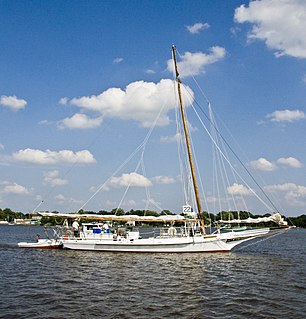
The Elsworth is a Chesapeake Bay skipjack, built in 1901 at Hudson, Maryland. She is a 39.9-foot-long (12.2 m) two-sail bateau, or "V"-bottomed deadrise type of centerboard sloop. She has a beam of 14.3', a depth of 3.1', and a gross registered tonnage of 8 tons. She is one of the 35 surviving traditional Chesapeake Bay skipjacks and a member of the last commercial sailing fleet in the United States.

Whitaker's Mill Historic District is a national historic district near Joppa, Harford County, Maryland, United States. It includes three early- to mid-19th-century buildings: the 2+1⁄2-story rubble stone Whitaker's Mill built in 1851, the 1+1⁄2-story rubble stone miller's house, and the log-and-frame Magness House, begun about 1800 as the miller's house for the first mill on the site. The district also includes an iron truss bridge known as Harford County Bridge No. 51, constructed in 1878, and the oldest such span in the county. The grist mill closed operations about 1900.


















